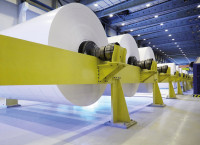Artificial intelligence (AI) is playing an increasingly important role in all areas of food production including cardboard as a packaging material. The interview with Ilkka Harju, Packaging Services Director at Metsä Board, shows how the approaches to integrating AI are being implemented at the Finnish company. Numerous approaches make it possible to save costs, increase efficiency and aim to offer customers more sustainable solutions all while maintaining stability.
sweets processing: How much does AI influence you personally in your day-to-day work?
IIlkka Harju: I use AI tools to streamline tasks, enhance productivity, and make more informed decisions. Whether it's analysing data faster, or generating content ideas, AI helps me work more efficiently. It also supports better time management by reducing manual effort, allowing me to focus on more strategic or creative aspects of my job. AI has become an integral part of my workflow and continues to evolve the way I approach daily challenges.
sp: Professionally, things are certainly a little different. What requirements must be met for AI to be used successfully in the packaging industry?
Harju: The successful introduction of artificial intelligence in the packaging industry is based on a combination of technical, data-based and organisational requirements. The definition of concrete, measurable, realistic and time-bound goals so-called SMART goals is key. They ensure that AI projects are set up in a targeted manner and bring demonstrable benefits.
sp: How does AI interfere with existing processes?
Harju: As AI processes often have a profound impact on existing workflows, well thought-out change management is required. Integration will only succeed smoothly if changes are actively organised. Collaboration with external partners such as AI providers, technology companies or research institutions is also crucial to success.
sp: Where is AI currently being used and what are the benefits?
Harju: AI is increasingly being used in the packaging industry particularly in design, production and logistics. It improves efficiency, quality and sustainability. AI models analyse large amounts of data for example on materials, dimensions or customer preferences and use this information to optimise packaging in terms of stability, material usage and costs. AI opens up new possibilities in packaging design in particular: It accelerates creative processes, suggests variants and supports the print design. Designers specify key parameters and the AI then develops various solutions. Standardised branding specifications can also be implemented efficiently, while design teams can concentrate on creative tasks.
sp: Is it that simple? Doesn't this require essential measurement data?
Harju: Not entirely. While AI opens powerful new possibilities, its effectiveness still depends on the availability and quality of essential measurement data. Input data such as material specs, performance metrics, consumer feedback, and environmental impact assessments are crucial for AI to generate meaningful and practical results. Without accurate and comprehensive data, the insights AI provides may be limited or misleading.
So, while AI is a powerful tool, it’s not a plug-and-play solution it requires careful data collection, validation, and ongoing human guidance to reach its full potential.
sp: What challenges are associated with the use of AI?
Harju: Despite great potential, implementation remains complex. Data problems are a key hurdle: incomplete, distorted or difficult to integrate information limits applicability. Technological challenges include the high computational requirements of modern AI models, their lack of explainability and the ongoing maintenance effort. At an organisational level, a lack of specialists, internal resistance and ethical issues make the introduction more difficult. In addition, there is often a lack of standardised interfaces to seamlessly integrate AI into existing systems. And last but not least, the economic benefits of AI projects are not always immediately demonstrable, which makes strategic investment decisions more difficult.
sp: Where is the greatest potential for AI in the packaging industry and specifically at Metsä Board?
Harju: There is great potential in the development of resource-saving packaging solutions that remain stable despite reduced material usage and offer reliable product protection. Generative design processes based on AI are opening up new avenues here particularly with regard to renewable materials.
sp: What other potential can be realised through AI?
Harju: AI can also contribute to the development of intelligent packaging for example through integrated sensors that monitor product condition and freshness. This improves traceability, reduces waste and supports sustainable supply chains. In logistics, AI enables more precise demand forecasts, optimised route planning and more efficient warehousing. This reduces costs and CO2 emissions along the entire value chain. Last but not least, AI also promotes individualisation: in future, packaging can be tailored more closely to personal preferences and consumer behaviour including individualised designs or messages. This creates new scope for brand communication and customer experience.
sp: Thank you for the interview and good luck with the integration of AI in your company.
http://www.metsagroup.com/metsaboard






